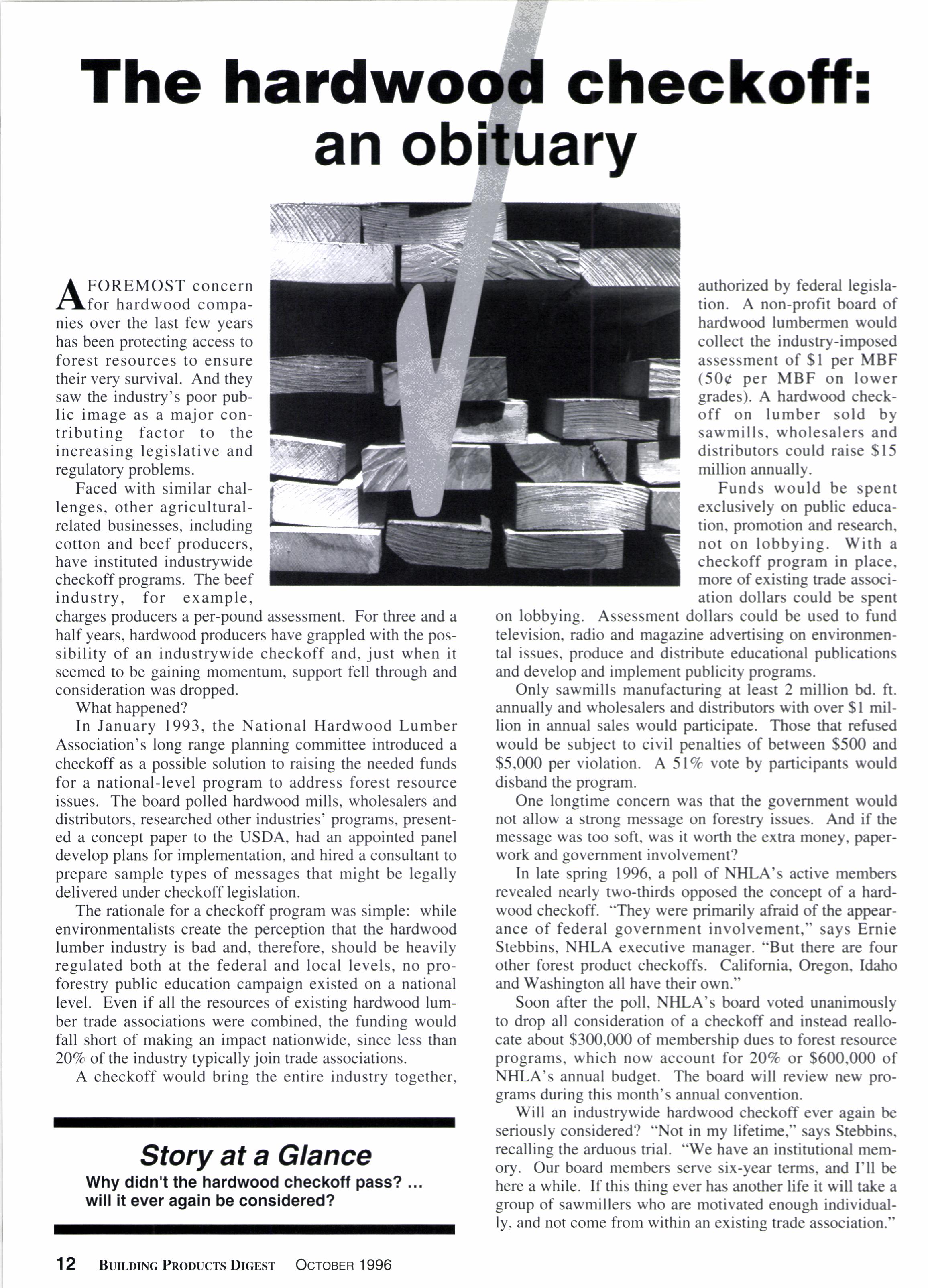
2 minute read
The hardwo checkoff: an ob ary
A FOREMOST concern
.Il,for hardwood companies over the last few years has been protecting access to forest resources to ensure their very survival. And they saw the industry's poor public image as a major contributing factor to the increasing legislative and regulatory problems.
Faced with similar challenges, other agriculturalrelated businesses, including cotton and beef producers, have instituted industrywide checkoff programs. The beef industry, for example, charges producers a per-pound assessment. For three and a half years, hardwood producers have grappled with the possibility of an industrywide checkoff and, just when it seemed to be gaining momentum, support fell through and consideration was dropped.
What happened?
In January 1993, the National Hardwood Lumber Association's long range planning committee introduced a checkoff as a possible solution to raising the needed funds for a national-level program to address forest resource issues. The board polled hardwood mills, wholesalers and distributors, researched other industries' programs, presented a concept paper to the USDA, had an appointed panel develop plans for implementation, and hired a consultant to prepare sample types of messages that might be legally delivered under checkoff legislation.
The rationale for a checkoff program was simple: while environmentalists create the perception that the hardwood lumber industry is bad and, therefore, should be heavily regulated both at the federal and local levels, no proforestry public education campaign existed on a national level. Even if all the resources of existing hardwood lumber trade associations were combined, the funding would fall short of making an impact nationwide, since less than 2OVo of the industry typicallyjoin trade associations.
A checkoff would bring the entire industry together,
Story at a Glance
Why didn't the hardwood checkoff pass? will it ever again be considered?
authorized by federal legislation. A non-profit board of hardwood lumbermen would collect the industry-imposed assessment of $l per MBF (50C per MBF on lower grades). A hardwood checkoff on lumber sold by sawmills. wholesalers and distributors could raise $15 million annually.
Funds would be spent exclusively on public education, promotion and research, not on lobbying. With a checkoff program in place, more of existing trade association dollars could be spent on lobbying. Assessment dollars could be used to fund television, radio and magazine advertising on environmental issues, produce and distribute educational publications and develop and implement publicity progmms.
Only sawmills manufacturing at least 2 million M. ft. annually and wholesalen and distributors with over $l million in annual sales would participate. Those that refused would be subject to civil penalties of between $500 and $5,000 per violation. A 5l% vote by participants would disband the program.
One longtime concern was that the government would not allow a strong message on forestry issues. And if the message was too soft, was it worth the extra money, paperwork and government involvement?
In late spring 1996, a poll of NHLA's active members revealed nearly two-thirds opposed the concept of a hardwood checkoff. "They were primarily afraid of the appearance of federal government involvement," says Ernie Stebbins, NHLA executive manager. "But there are four other forest product checkoffs. California, Oregon, Idaho and Washington all have their own."
Soon after the poll. NHLA's board voted unanimously to drop all consideration of a checkoff and instead reallocate about $300,000 of membership dues to forest resource programs, which now account for 2OVc or $600,000 of NHLA's annual budget. The board will review new programs during this month's annual convention.
Will an industrywide hardwood checkoff ever again be seriously considered? "Not in my lifetime," says Stebbins, recalling the arduous trial. "We have an institutional memory. Our board members serye six-year terms, and I'll be here a while. If this thing ever has another life it will take a group of sawmillers who are motivated enough individually, and not come from within an existing trade association."

